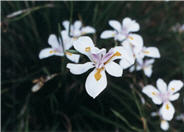
Common name:Olive, Edible Olive
Botanical name:Olea europaea
This broad tree will slowly grow to 20'-30' tall and wide. It has small, grey-green, evergreen leaves. Small white fragrant flowers bloom in spring, followed by fleshy black fruit that appears in fall. Fruit is messy and can stain sidewalks. There are cultivars that do not produce fruit. Some folks are allergic to the blooms. This tree is very long lived, with a beautiful gnarled trunk. It prefers full sun and low watering in summer months (twice a month) and none during the winter, when established.

Common name:Trailing or Prostrate Germander
Botanical name:Teucrium X lucidrys 'Prostratum'
This cushion-like ground cover reaches only 6" tall and 2' spreading. White or red-purple summer flowers appear in loose spikes, attracting bees. Leaves are evergreen, toothed and densely cover this ground cover. This plant needs well draining soil as it cannot stand wetness around its roots. It tolerates poor and rocky soil and full sun.

Common name:Golden Breath Of Heaven
Botanical name:Coleonema pulchellum 'Sunset Gold'
Sunset Gold Breath of Heaven is a fine textured, low growing shrub to 10" high and wide with bright yellow foliage. It is excellent for rock gardens. It is drought tolerant. -Cornflower Farms

Common name:Blue Fescue, Blue Fescue Grass
Botanical name:Festuca glauca
This ground cover/grass will grow less than 1' tall and has small, blue-green, evergreen leaves that are very thin and hair-like. Flowers appear in the summer but are insignificant. This dependable ground cover prefers full sun in coastal areas and afternoon shade in warm inland areas. It needs well draining soil and is drought tolerant once it's established. Leaves may burn during the summer but trim in winter to keep it looking refreshed.

Common name:California Fescue
Botanical name:Festuca californica
The California Fescue is a cool season bunchgrass with blue-green blades that reach 2' high. The violet colored flower stalks are 5' tall, appearing in spring and summer, creating fountain-like clumps. This grass is drought tolerant for sun and shade although it looks better with additional summer water. The California fescue is native to CA and is a beneficial insect plant. Plant on dry sunny slopes or on the edge of a dry creek bed.

Common name:Southwest Coral Bells
Botanical name:Heuchera sanguinea
Tufts of round leaves 2"-3" wide with scalloped edges accent this plant. It also produces wiry stems to 24" tall with open clusters of red-pink, bell-shaped flowers.

Common name:Butterfly Iris or Fortnight Lily
Botanical name:Dietes iridioides
This clumping evergreen iris bears tall, narrow leaves to 30" tall and white flowers marked purple in the center on stalks to 3' tall, appearing spring through fall. This variety has stiffer, darker foiliage than the bicolor form. It requires sun to part shade with little or no summer watering when established. This is a very reliable plant. Divide every 3-5 years to keep it looking fresh.

Common name:Hidcote English Lavender
Botanical name:Lavandula angustifolia 'Hidcote'
This is a slow growing lavender that grows to 1' tall with deep purple flowers. It is drought tolerant, attracts hummingbirds and butterflies. -Cornflower Farms

Common name:White Gaura
Botanical name:Gaura lindheimeri
White Gaura is a profusely flowering perennial for all zones that grows 2'-4' high. It has pink buds that open to showy white flowers in spring and fall. It needs full sun and is drought tolerant.
-Cornflower Farms
More than half of the water used at your home is for outside purposes. Studies show that on average, half of the water used outdoors is wasted. The leading cause of waste is incorrectly set and poorly managed irrigation controllers. The second biggest cause of wastage is broken irrigation equipment that goes undetected. There are a few basic things you can do to make a big difference in your water use.
Click in the green box for more information
Designer:
Photographer: GardenSoft
Maintain a two to four inch layer of mulch on the soil surface to reduce weeds, infiltrate rain water, and reduce compaction.
Attract, or buy beneficial insects such as ladybugs and lacewings to control pest outbreaks in your garden.